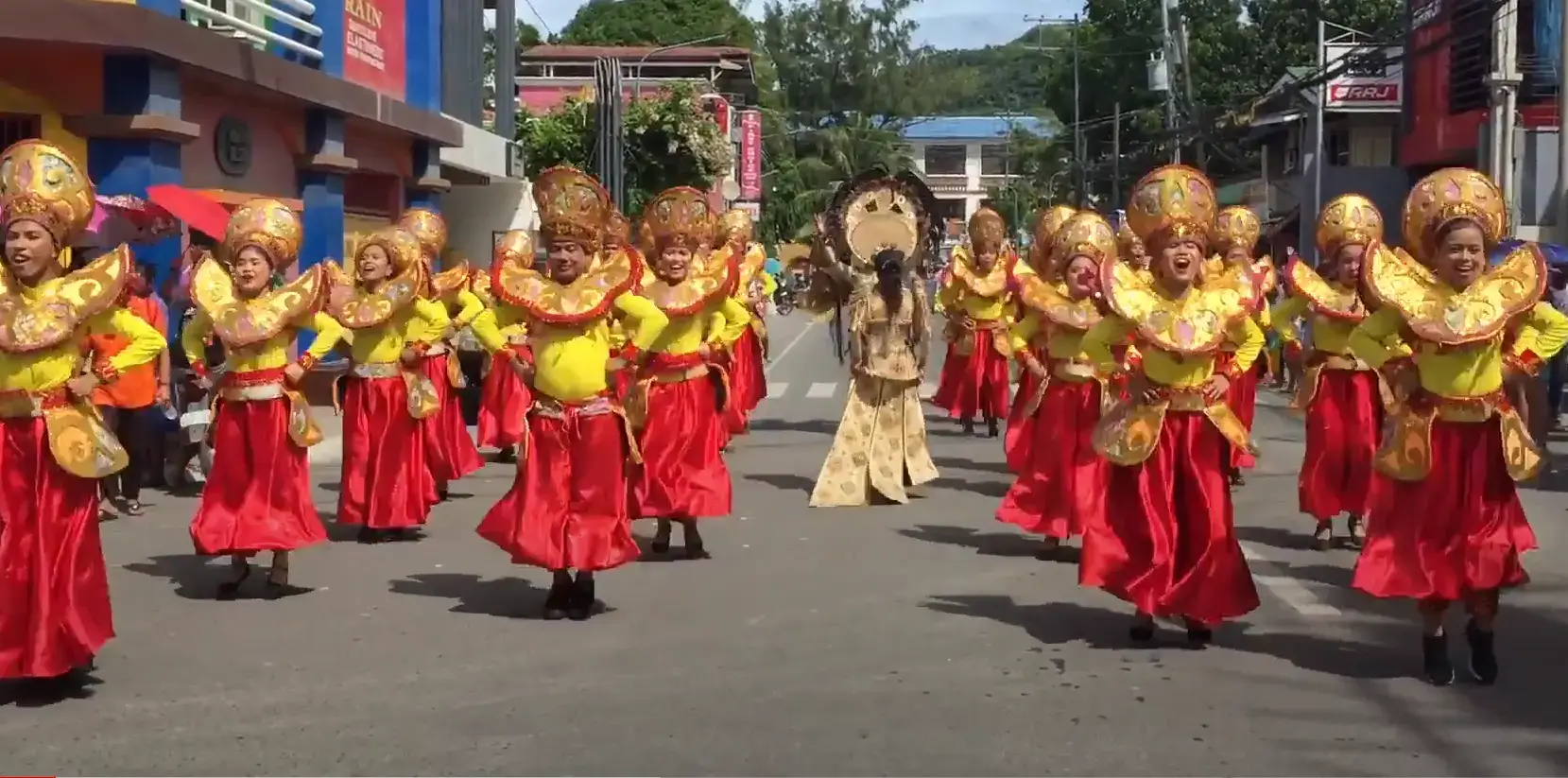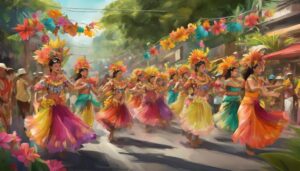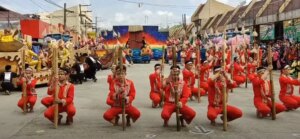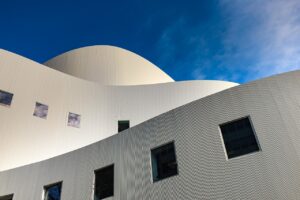
Banigan-Kawayan Festival
The Banigan-Kawayan Festival is an annual celebration held every last week of September in Basey, Samar, Philippines. This vibrant festival revolves around two key elements: the banig and the kawayan, representing the local crafts industry.
Facts About The Banigan-Kawayan Festival
| Facts | Explanation |
|---|---|
| Name of the Festival | Banigan-Kawayan Festival |
| Type of Festival | Cultural Festival |
| City of Origin | Basey, Samar, Philippines |
| Festival Etymology | The festival’s name is derived from two local materials: “banig” which means mat and “kawayan” which means bamboo. These materials represent the ingenuity and craftsmanship of the people in Basey, Samar. |
| Date First Celebrated | January 18, 1998 |
| Founder of the Festival | Mayor Junjie Fuentes initiated and founded the Banigan-Kawayan Festival as a way to showcase the rich cultural heritage and traditions of Basey, Samar. |
| Brief History of the Festival | The Banigan-Kawayan Festival was first celebrated in 1998 and has since become an annual event in Basey, Samar. It aims to promote the local culture and arts, particularly highlighting the skillful weaving of mats (banig) and the use of bamboo (kawayan) in various traditional crafts. The festival features vibrant street dances, colorful parades, cultural performances, exhibitions, and contests that showcase the creativity and craftsmanship of the locals. It has become a significant celebration that brings together the community and attracts visitors from different parts of the country. |
| Brief History of the City | Basey is a coastal municipality located in the province of Samar, Philippines. It is known for its scenic landscapes, pristine beaches, and rich cultural heritage. The town has a historical significance as it played a role during World War II. Basey is also famous for its production of intricate mats and handicrafts made from indigenous materials like buri and pandan leaves. The city offers a glimpse into the traditional way of life in Samar and attracts tourists who appreciate its natural beauty and cultural heritage. |
| Ethnic Information | The majority of the population in Basey belongs to the Waray ethnic group, which is one of the indigenous groups in the Eastern Visayas region of the Philippines. The Waray people have their distinct language, traditions, and customs that are showcased during the Banigan-Kawayan Festival. |
| Location in the Country | Basey is situated on the island of Samar in the Eastern Visayas region of the Philippines. It is located southeast of Tacloban City, the regional capital of Eastern Visayas. |
| How to Reach the City | The most convenient way to reach Basey is by flying to Tacloban City’s Daniel Z. Romualdez Airport and then taking a land transportation such as van or bus to Basey. The travel time from Tacloban City to Basey is approximately 1-2 hours, depending on traffic conditions. |
| Nearby Cities or Towns | – Tacloban City: 14 km – Guiuan: 91 km – Calbayog City: 95 km – Borongan City: 103 km – Catbalogan City: 116 km |
| Google Map Link | Basey, Samar |
| Festival Main Events and Activities | – Street dances showcasing traditional dances and music – Parade featuring colorful floats adorned with intricate bamboo and mat designs – Exhibitions of locally-made handicrafts and products – Cultural performances showcasing traditional music, dance, and theater arts – Contests such as mat-weaving competitions and traditional games – Food fairs offering a variety of local delicacies – Fireworks display – Beauty pageants promoting local talent and beauty |
| Other Famous Tourist Attractions in the City | – Sohoton Caves: A system of caves known for its stunning rock formations and clear blue waters – Tarangban Falls: A picturesque waterfall nestled in lush greenery – San Juanico Bridge: A famous landmark connecting Samar and Leyte provinces – Balantak Falls: A serene waterfall ideal for swimming and picnicking – Lulugayan Falls: A scenic waterfall surrounded by natural beauty – Sohoton Natural Bridge National Park: A protected area with caves, rivers, and diverse flora and fauna |
| Famous Food Dishes of the City | – Binagol: A sweet delicacy made from grated root crops, coconut milk, and nuts, wrapped in banana leaves – Moron: Sticky rice cake mixed with chocolate and wrapped in banana leaves – Suman sa Lihiya: Sticky rice cake cooked with lye water and served with coconut caramel sauce – Baye-Baye: A local snack made from ground glutinous rice mixed with coconut milk and sugar – Kinilaw nga Puso sang Saging: A salad made from banana blossoms marinated in vinegar, spices, and coconut milk |
| Landmarks in the City | – St. Michael the Archangel Church: A historic church dating back to the Spanish colonial era – Basey Municipal Hall: A government building with architectural significance – Basey River: A scenic river perfect for boat tours and water activities – Lintaon Peak: An elevated area offering panoramic views of Basey and its surrounding landscapes |
| Related Festivals in the Same Region | – Pintados-Kasadyaan Festival (Tacloban City) – Sangyaw Festival (Tacloban City) – Karatong Festival (Dulag, Leyte) – Buyogan Festival (Abuyog, Leyte) – Kawayan Festival (Borongan City) |
History and Significance
The Banigan-Kawayan Festival is an annual celebration held in the municipality of Basey in Samar, Philippines. It is a cultural event that showcases the rich history and significance of the banig (mat) and kawayan (bamboo) in the local community.
The festival traces its roots back to the pre-colonial era when the people of Basey relied heavily on the banig and kawayan for their livelihood and daily needs. The banig, traditionally made from pandan leaves, served as a multipurpose mat used for sleeping, sitting, and even as a flooring material. On the other hand, kawayan played a vital role in constructing houses, making tools, and crafting various household items.
The Banigan-Kawayan Festival aims to honor and promote these traditional crafts by showcasing various activities, such as banig weaving demonstrations, bamboo carving exhibitions, and cultural performances. The festival also includes a grand parade where participants wear colorful costumes adorned with banig and bamboo designs.
Through the Banigan-Kawayan Festival, the people of Basey can preserve and pass down their cultural heritage to future generations. The event not only highlights the historical significance of the banig and kawayan but also serves as a platform for local artisans to showcase their skills and craftsmanship.
Moreover, the festival has become a major tourist attraction, drawing visitors from different parts of the country and even abroad. It not only provides an opportunity for cultural exchange but also helps boost the local economy through tourism-related activities.
Overall, the Banigan-Kawayan Festival stands as a testament to the rich history and significance of the banig and kawayan in the municipality of Basey. It serves as a reminder of the community’s cultural identity and serves as a platform for preserving and sharing their traditional crafts with the world.
Getting There
To reach the city of Basey in Samar, Philippines, you have several transportation options available. Here is a detailed guide on how to reach the city:
- By Air: The most convenient way to reach Basey is by flying to Tacloban City’s Daniel Z. Romualdez Airport. Several domestic airlines operate regular flights to Tacloban City from major cities in the Philippines. Once you land at the airport, you can proceed to the next step.
- By Land: From Tacloban City, you can take land transportation such as a van or bus to Basey. These are readily available at the airport or in Tacloban City proper. The travel time from Tacloban City to Basey is approximately 1-2 hours, depending on traffic conditions and the mode of transportation you choose.
- Van: Vans are a popular mode of transportation for travelling between Tacloban City and Basey. They are usually more comfortable and offer faster travel times compared to buses. You can find van terminals near the airport or in downtown Tacloban City.
- Bus: If you prefer a more budget-friendly option, you can take a bus from Tacloban City to Basey. Bus terminals are located in downtown Tacloban City, and you can inquire about the schedules and fares at the terminal.
It’s important to note that transportation availability and schedules may vary, so it’s advisable to check with local sources or travel agencies for the most up-to-date information before your trip. Additionally, consider allowing some flexibility in your travel plans to account for any unforeseen circumstances.
Overall, flying to Tacloban City and then taking a van or bus to Basey is the recommended route for reaching the city. This transportation option ensures a convenient and enjoyable journey, allowing you to explore the vibrant Banigan-Kawayan Festival and experience the cultural richness of Basey, Samar.
Location Of Basey in Samar
Main Events and Activities
The Banigan-Kawayan Festival is a celebration held in the municipality of Basey, Samar in the Philippines. It showcases the rich cultural heritage of the town and its people. Here are some of the main events and activities that take place during the festival:
- Street Dancing Competition: One of the highlights of the festival is the street dancing competition. Participants from different barangays (villages) in Basey showcase their traditional dances and colorful costumes as they parade through the streets. The performances are accompanied by lively music and intricate choreography.
- Banig Weaving Demonstrations: Basey is known for its intricate banig weavings, which are traditional mats made from buri leaves. During the festival, visitors have the opportunity to witness banig weaving demonstrations by skilled artisans. They can also try their hand at weaving and learn more about this important craft.
- Kawayan (Bamboo) Crafts Exhibit: Another main attraction of the festival is the Kawayan Crafts Exhibit. Local craftsmen display their bamboo products, ranging from furniture and home decor to accessories and musical instruments. Visitors can admire the craftsmanship and purchase unique bamboo items as souvenirs.
- Agro-Industrial Fair: The festival also features an agro-industrial fair where local farmers and entrepreneurs showcase their agricultural products, handicrafts, and other locally-made goods. It’s a great opportunity to sample delicious local delicacies and support the local economy.
- Cultural Performances: Throughout the festival, various cultural performances highlight the traditional music, dances, and rituals of Basey. These performances provide a glimpse into the rich cultural heritage of the town and its people.
- Beauty Pageant: The festival culminates with the Banigan-Kawayan Festival Queen pageant. Candidates from different barangays compete for the crown, showcasing their beauty, talent, and knowledge about Basey’s culture and traditions.
These are just some of the main events and activities that you can expect to see during the Banigan-Kawayan Festival in Basey, Samar.
Culinary Delights in Basey
When you visit Basey, be prepared to embark on a mouthwatering culinary journey that will delight your taste buds and immerse you in the city’s cultural richness. Indulge in the local culinary delights, where each dish tells a story of tradition and flavor.
Start your gastronomic adventure by savoring the succulent ‘lechon baboy’ (roast pig), a local favorite that boasts crispy skin and tender, juicy meat. The aroma and taste of this delicacy will leave you craving for more.
As you continue your culinary exploration, make sure to try the delightful ‘binagol’ dessert. This sweet treat is made from sweetened taro and rice, creating a unique combination of flavors and textures that will captivate your senses.
With every bite, you’ll discover the passion and expertise that goes into each dish, showcasing the culinary heritage of Basey. From the rich flavors to the vibrant colors, every culinary creation reflects the city’s cultural diversity and love for food.
Tips for Attending the Banigan-Kawayan Festival:
If you plan to join the Banigan-Kawayan Festival, immerse yourself in the rich local customs and traditions. As a sign of respect, it is advisable to dress modestly, reflecting the cultural values of the festival.
Don’t forget to bring essential sun protection such as wide-brimmed hats and sunscreen to ensure a comfortable experience under the summer sun.
To make the most out of your visit, aim to be there on the main festival day when the grand parade takes place. This is the pinnacle of the event, where you can witness the captivating display of vibrant floats, traditional music, and lively dances.
Capture the spirit of the festival by joining in the festivities, interacting with locals, and indulging in the delicious traditional delicacies.
By following these tips, you can fully immerse yourself in the Banigan-Kawayan Festival experience and create lasting memories of this vibrant celebration.
Exploring the City: Discover the Hidden Gems of Basey
Basey is not just about the Banigan-Kawayan Festival. It also offers a plethora of breathtaking tourist spots that are worth a visit. Immerse yourself in the awe-inspiring beauty of the Sohoton Caves, where you can marvel at the magnificent rock formations and explore the hidden chambers.
Make sure to venture to the Natural Bridge Park, a true natural wonder where a massive rock arch spans over a serene river, creating a picturesque setting that will leave you in awe.
But that’s not all! Basey is also a hub of cultural events and festivities. While you’re in the region, don’t miss out on the vibrant and colorful Pintados-Kasadyaan Festival in Tacloban.
It’s a celebration that showcases the rich cultural heritage and traditions of the local community, featuring grand parades, traditional dances, and captivating performances that will transport you into a world of vibrant colors and infectious energy.
Surprising Facts About The Banigan-Kawayan Festival
- 🌾 The Banigan-Kawayan Festival is a unique celebration held in the municipality of Basey, located in the Samar province of the Philippines.
- 🎋 The festival’s name is derived from two local materials: “Banig,” which refers to handwoven mats made from indigenous materials, and “Kawayan,” which means bamboo.
- 🚣♂️ One of the festival’s highlights is the fluvial procession along the Basey River, where intricately decorated bamboo rafts and boats showcase the town’s craftsmanship.
- 🎶 Traditional folk music and dances are integral to the Banigan-Kawayan Festival, with locals showcasing their talents in rhythmic performances that tell stories of their cultural heritage.
- 🎭 The festival features a unique street theater competition called “Lanay Ha Kalsada,” where participants creatively present stories through theatrical performances on the streets of Basey.
- 🍲 Food plays a significant role in the festivities, and visitors can enjoy a variety of local delicacies prepared using bamboo as a primary cooking tool, adding a distinct flavor to the culinary experience.
- 🖼️ A bamboo art exhibit is organized as part of the festival, displaying the diverse ways in which bamboo is utilized for artistic expression, ranging from sculptures to functional crafts.
- 🌳 Environmental consciousness is promoted during the Banigan-Kawayan Festival, emphasizing the sustainable use of bamboo and other natural resources in the region.
- 🎨 The festival serves as a platform for local artisans and weavers to showcase their skills, fostering a sense of community pride and preserving traditional crafts.
- 🌏 Banigan-Kawayan Festival has gained recognition for its commitment to cultural preservation and eco-friendly practices, making it not just a celebration but also a symbol of responsible tourism in the Philippines.
Conclusion
The Banigan-Kawayan Festival is more than just a celebration; it’s a living testament to Basey’s cultural richness and communal unity. It offers a unique opportunity to appreciate local traditions and crafts, savor delectable regional cuisine, and experience the warmth of the Basey people.
Whether you’re a festival enthusiast or a cultural explorer, the Banigan-Kawayan Festival promises a memorable experience filled with color, music, dance, and an undeniable sense of community. Here’s an invitation to immerse yourself in this vibrant celebration and discover the beauty of Filipino culture and tradition.







